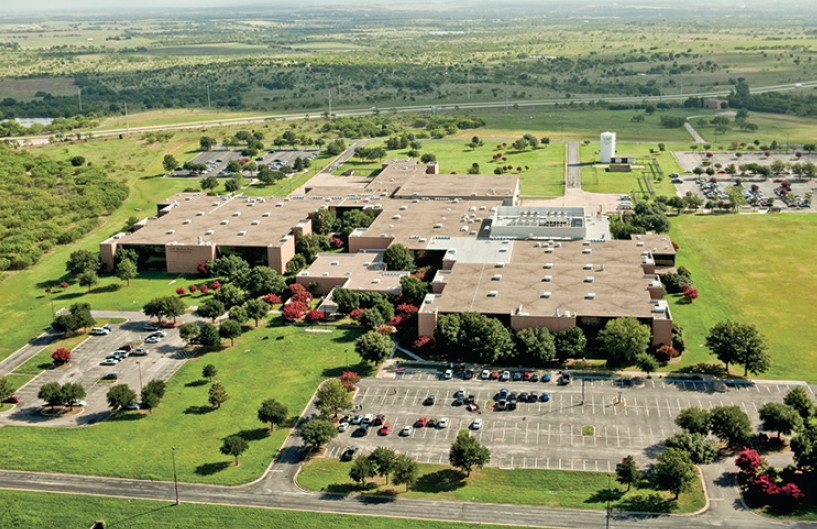University-managed Research Facilities
Making the case for university-industry partnerships that lead to creative innovations
What is a university-managed research facility?
University-managed facilities are labs, equipment, space and technology — any kind of infrastructure — that enable faculty, students and external research partners to conduct high-level, solutions-based research in key areas. This infrastructure — from physical space to high-end research equipment to innovative technology — is key to research that leads to discovery or enrichment in a field. Often, the unique suites of equipment are housed together in a shared facility or at a research park where the environment itself fosters collaboration and new ideas.
Why use a university-managed research facility?
University-managed research facilities are unique in that they enable internal collaborations and access to equipment beyond the reach of most individual researchers. With these facilities, comes the brainpower and manpower to research, execute and commercialize new ideas. A university has researchers — experts in chosen fields — who have dedicated themselves to exploring, testing and creating solutions. And through shared research facilities, they have the latest, high-tech equipment and space to carry out the most sophisticated research projects and analysis.
In addition to providing central support for high-cost equipment and ongoing maintenance, university-managed facilities enable:
- Combined resources to offer researchers high-tech equipment and to update it in a more timely manner
- Increased efficiency and collaboration among university and external researchers who are sharing space and equipment
- Designated space for top-level research projects in key fields
- Shared laboratory managers and technicians who care for the equipment and provide expertise to faculty, students and external partners
What are the benefits of a university research park?
As noted by the Association of University Research Parks, “University research parks provide a best practice means of focusing on innovation and sustaining economic competitiveness.” More simply put, a university research, such as UNT's Discovery Park can catalyze technology-based economic development. By their very nature and design, university research parks can foster good university-industry partnerships by bringing academics and entrepreneurship together in one place. Proximity matters. The ability to work together in person promotes a quicker, more dynamic exchange of ideas, experience and expertise.
Location matters. Startups and high tech firms often form around universities and research parks. These firms take advantage of the innovative research, highly skilled labor and resources that universities offer. Think Silicon Valley to Stanford University. Or the Research Triangle to University North Carolina-Chapel Hill, North Carolina State University and Duke University.
UNT's Discovery Park
 The North Texas region's largest research park with nearly 300 acres of space dedicated to the sciences, technology and engineering, UNT's Discovery Park is located 5 miles north of the UNT main campus in Denton, Texas. It includes a 554,000 square foot building, which also is occupied by the College of Engineering, the College of Information and the Center for Information and Computer Security and supports interactive and multidisciplinary STEM (Science, Technology, Engineering and Mathematics) research, education and training that benefits students, faculty and the community, and expands economic development by developing industry-university partnerships.
The North Texas region's largest research park with nearly 300 acres of space dedicated to the sciences, technology and engineering, UNT's Discovery Park is located 5 miles north of the UNT main campus in Denton, Texas. It includes a 554,000 square foot building, which also is occupied by the College of Engineering, the College of Information and the Center for Information and Computer Security and supports interactive and multidisciplinary STEM (Science, Technology, Engineering and Mathematics) research, education and training that benefits students, faculty and the community, and expands economic development by developing industry-university partnerships.
UNT's Discovery Park features several state-of-the-art research labs such as the Materials Research Facility (MRF), a facility with high-powered microscopes for 3-D characterization and processing, and the Greenhouse Complex, a climate-controlled facility equipped with an expandable infrastructure to accommodate diverse growing conditions, including high ceilings to grow sugarcane and other tall plants.
Generating creative innovation
Between 2012 and 2013, research at public universities led to more than:
- 522 startups launched
- 3,278 patents awarded
- 3,094 licenses issued
− Association of University Technology Managers
Why should you consider UNT?
As UNT has expanded its research enterprise, the university has built exceptional research facilities and martialed expertise in an array of innovative research areas to develop its capability for fundamental and applied research, technology transfer, and ultimately business incubation. This is key to encouraging startups and partnering with industry and business to commercialize research that tackles real-world issues.
"State-of-the-art labs and high-end research equipment are key to research that leads to discovery and solutions. At UNT, we’ve built exceptional research facilities and are creating even more, so our researchers — both faculty and students — can push the boundaries of science, technology and creativity."
− Neal Smatresk, UNT President
Visit our facilities
Tours of UNT’s research facilities — including Discovery Park — are available year round for industry and businesses, educators, prospective students and community partners.
Email: untresearch@unt.edu
Places for innovation and creation
UNT’s 900-acre campus features laboratories of all kinds where faculty researchers push the boundaries of science, technology and creativity while providing students hands-on experience to ready them for their future careers. In many of these laboratories, faculty and student researchers already are partnering with each other and industry. UNT labs can be "put to work" to investigate, beta test and produce solutions and real-world applications. Faculty and students work alongside industry leaders to apply their knowledge in solving real-world problems and creating new products and technologies.
Shared facilities include:

Developing materials
At UNT's Materials Research Facility (MRF), we have developed one of the most advanced university research facilities in the nation for materials analysis — from the atomic to macro scales. The facility offers a suite of powerful analytical instruments used for true 3-D characterization and processing with an adjoining cleanroom so that materials can be synthesized, tested and controlled in close proximity. UNT is among an elite group of public institutions nationwide to offer these open access resources.

Analyzing bio materials
UNT's BioAnalytical Facility provides a diverse collection of services and equipment for industry, ranging from big pharma to small and commercial agriculture. The facility includes top-of-the-line mass spectrometers and the patented nanomanipulator, which connects to a high-powered microscope and is controlled with a joystick to allow scientists to identify and focus on a single cell.

Living labs
The Lewisville Lake Environmental Learning Area (LLELA), which sits just south of Lewisville Lake, is a living lab perfect for scientific research and environmental education purposes and provides unique opportunities for hands-on training with its vast prairieland, array of animals and diversity of waterways, including the Elm Fork of the Trinity River. And the Lewisville Aquatic Ecosystems Research Facility, one of the many labs located within LLELA and administered by the U.S. Army Corps of Engineers, offers additional opportunities to research and help restore the ecosystems in Texas lakes and rivers.

Solving logistics issues
Housed in UNT’s Business Leadership Building, the Jim McNatt Institute for Logistics Research offers interactive logistics simulations, business intelligence, data visualization and complex logistics systems modeling, including 3D modeling. It allows faculty and students to partner with logistics companies to engage in applied research that could help companies more efficiently manage the distribution of goods and services and cut costs.

Supercomputing
Located in the heart of campus, TALON is a high-performance supercomputing facility that provides a tenfold increase in computational power by featuring high-speed networks, advanced software and storage to facilitate advanced computational processing across disciplines and industries. More than 400 researchers have used it to expand their reach in computational-based research analysis.
